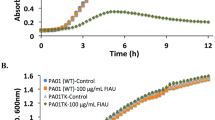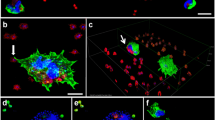Abstract
Purpose
Previously, we demonstrated specific accumulation into bacteria of a 12-mer phosphorodiamidate morpholino (MORF) oligomer complementary to a ribosomal RNA (rRNA) segment found in all bacteria using the universal probe called Eub338 (Eub). Here, two MORF oligomers Eco and Kpn with sequences specific to the rRNA of Escherichia coli (Eco) and Klebsiella pneumoniae (Kpn) were investigated along with Eub and control (nonEub).
Procedures
To determine bacterial rRNA binding, oligomers were tagged with Alexa Fluor 633 (AF633) for fluorescence in situ hybridization (FISH) and fluorescence microscopy, and radiolabeled with technetium-99m (Tc-99m) for biodistribution and SPECT imaging in infected mice.
Results
By both FISH and fluorescence microscopy, Eub showed a positive signal in both E. coli and K. pneumoniae as expected, and Kpn showed significantly higher accumulation in K. pneumoniae with near background in E. coli (p < 0.01). Conversely, Eco was positive in both E. coli and K. pneumoniae, hence nonspecific. As determined by biodistribution, the accumulation of [99mTc]Kpn was higher in the thigh infected with live K. pneumoniae than with live E. coli (p = 0.05), and significantly higher than with heat-killed K. pneumoniae (p = 0.02) in the target thigh. By SPECT imaging, the accumulation of [99mTc]Kpn was obviously higher in its specific target of K. pneumoniae compared to an E. coli infected thigh.
Conclusions
Kpn complementary to the rRNA of K. pneumoniae, labeled with Tc-99m or AF633, demonstrated specific binding to fixed and live K. pneumoniae in culture and in infected mice such that Tc-99m-labeled Kpn as the MORF oligomer may be useful for K. pneumoniae infection detection through imaging.






Similar content being viewed by others
References
Amann RI, Krumholz L, Stahl DA (1990) Fluorescent-oligonucleotide probing of whole cells for determinative, phylogenetic, and environmental studies in microbiology. J Bacteriol 172(2):762–770
Kempf VA, Trebesius K, Autenrieth IB (2000) Fluorescent in situ hybridization allows rapid identification of microorganisms in blood cultures. J Clin Microbiol 38(2):830–838
Ouverney CC, Fuhrman JA (1997) Increase in fluorescence intensity of 16S rRNA in situ hybridization in natural samples treated with chloramphenicol. Appl Environ Microbiol 63(7):2735–2740
Moter A, Gobel UB (2000) Fluorescence in situ hybridization (FISH) for direct visualization of microorganisms. J Microbio Meth 41:85–112
Giovannoni SJ, DeLong EF, Olsen GJ et al (1988) Phylogenetic group-specific oligodeoxynucleotide probes for identification of single microbial cells. Bacteriol 170(2):720–726
Summerton JE (2007) Morpholino, siRNA, and S-DNA compared: impact of structure and mechanism of action on off-target effects and sequence specificity. Curr Top Med Chem 7:651–660
Liu G, Mang’era K, Liu N et al (2002) Tumor pretargeting in mice using (99m)Tc-labeled morpholino, a DNA analog. J Nucl Med 43(3):384–391
Liu G, He J, Dou S et al (2004) Pretargeting in tumored mice with radiolabeled morpholino oligomer showing low kidney uptake. Eur J Nucl Med Mol Imaging 31(3):417–424
Chen L, Wang Y, Cheng D et al (2013) 99mTc-MORF oligomers specific for bacterial ribosomal RNA as potential specific infection imaging agents. Bioorg Med Chem 21(21):6523–6530
Wang Y, Chen L, Liu X et al (2013) Detection of Aspergillus fumigatus pulmonary fungal infections in mice with (99m)Tc-labeled MORF oligomers targeting ribosomal RNA. Nucl Med Biol 40(1):89–96
Geller BL, Deere JD, Stein DA et al (2003) Inhibition of gene expression in Escherichia coli by antisense phosphorodiamidate morpholino oligomers. Antimicrob Agents Chemother 47(10):3233–3239
Wang Y, Liu G, Hnatowich DJ (2006) Methods for MAG3 conjugation and 99mTc radiolabeling of biomolecules. Nat Protocols 1:1477–1480
Sheridan GEC, Masters CI, Shallcross JA et al (1998) Detection of mRNA by reverse transcription-PCR as an indicator of viability in Escherichia coli cells. Appl Environ Microb 64(4):1313–1318
Kallen AJ, Hidron AI, Patel J et al (2010) Multidrug resistance among Gram-negative pathogens that caused healthcare-associated infections reported to the national healthcare safety network, 2006–2008. Infect Control Hosp Epidemiol 31(5):528–531
Sahm DF, Thornsberry C, Mayfield DC et al (2001) Multidrug-resistant urinary tract isolates of Escherichia coli: prevalence and patient demographics in the United States in 2000. Antimicrob Agents Chemother 45(5):1402–1406
Deere J, Iversen P, Geller BL (2005) Antisense phosphorodiamidate morpholino oligomer length and target position effects on gene-specific inhibition in Escherichia coli. Antimicrob Agents Chemother 49:249–255
Uyttendaele M, Bastiaansen A, Debevere J (1997) Evaluation of the NASBA nucleic acid amplification system for assessment of the viability of Campylobacter jejuni. Int J Food Microbiol 37:13–20
Aellen S, Que YA, Guignard B et al (2006) Detection of live and antibiotic-killed bacteria by quantitative real-time PCR of specific fragments of rRNA. Antimicrob Agents Chemother 50(6):1913–1920
Acknowledgments
Funding was provided by a grant from NIH no. AI070857.
Author information
Authors and Affiliations
Corresponding author
Ethics declarations
Conflict of Interest
The authors declare that they have no conflict of interest.
Ethics Approval
The studies in mice were with the approval of the Institutional Animal Care and Use Committee.
Rights and permissions
About this article
Cite this article
Chen, L., Cheng, D., Liu, G. et al. Detection of Klebsiella. Pneumoniae Infection with an Antisense Oligomer Against its Ribosomal RNA. Mol Imaging Biol 18, 527–534 (2016). https://doi.org/10.1007/s11307-015-0927-4
Published:
Issue Date:
DOI: https://doi.org/10.1007/s11307-015-0927-4




